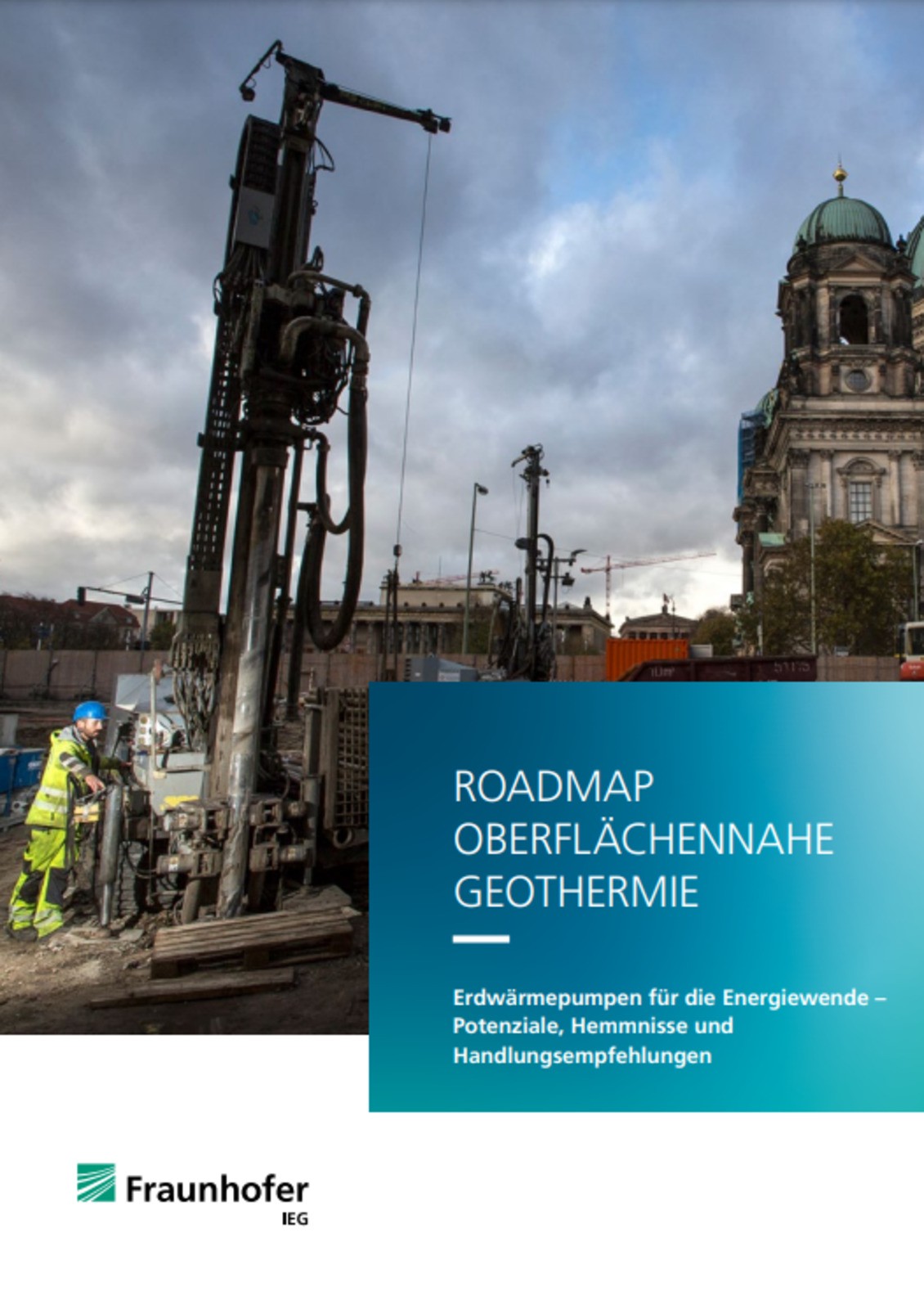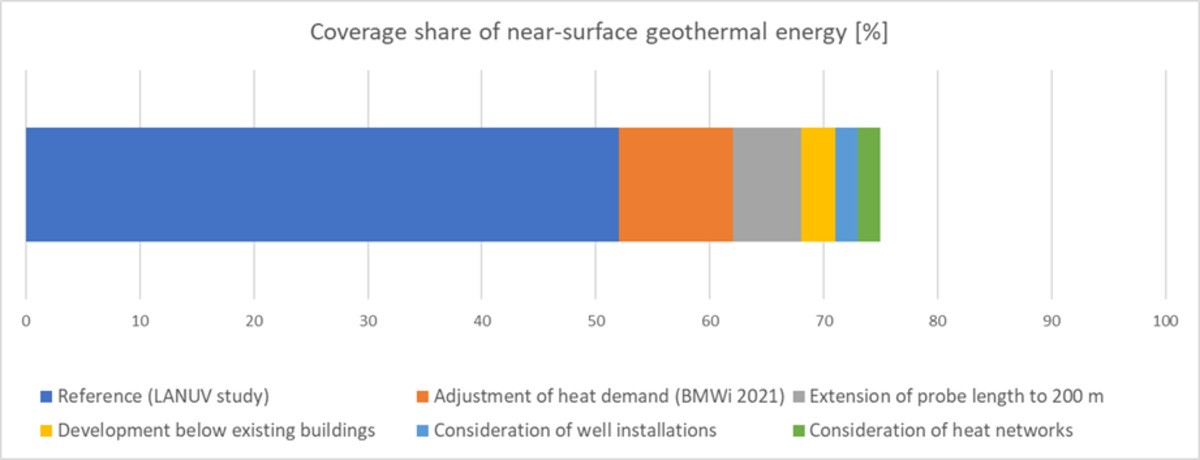Future role and potential of near-surface geothermal energy in Germany determined !
D2Grids Project

The Fraunhofer IEG, Fraunhofer Institute for Energy Infrastructures and Geothermal Energy IEG, with the support of the German Geothermal Energy Association (BVG), the German Heat Pump Association (BWP) and the Geothermal Energy Community, published the Roadmap Near-Surface Geothermal Energy in June 2022.
In addition to the question of what role geothermal heat pumps can and should play in the energy system of the future, the potential and what contribution they are capable of making were determined. This potential is independent of whether it is used in individual solutions (a house / a geothermal probe / a heat pump) or as a source for 5th generation heating and cooling networks.
Potential for ground-source heat pumps in Germany
Regardless of the technical and ecological advantages of ground-source heat pumps, it is important to know what contribution this technology can actually make to the heat transition. How many conventional heating systems can be replaced by ground-source heat pumps? What amount of energy can be transformed?
This question must be answered in the context of the building stock in Germany. Geothermal heat pumps are a local energy source that cannot be transported over long distances. The potential of the subsurface can therefore only be evaluated where it can be used directly for heating and hot water production purposes. A blanket evaluation of the underground is therefore not expedient.
Basically, it must be stated that the subsoil has no specific performance or yield, but always reacts to the requirements of the heat sink, usually the heat pump or the building. Thus, when determining the potential of geothermal heat pumps, the triad of the properties of the subsoil, the operating mode of the heat pump and the load requirement of the heat sink or the 5GDHC grid must always be considered. For this reason, the potential of ground-source heat pumps for the provision of heating and domestic hot water in Germany has not yet been comprehensively determined.
Although the individual federal states provide important planning data and bases in their online portals, they do not intersect this data with local building requirements. Therefore, the actual potential of geothermal heat pumps for the respective location (building, plot, neighbourhood, etc.) is not known.
In addition to the local geothermal potential of the subsurface, the actual potential also describes the available open space of the property, the demand characteristics of the building(s) to be supplied, the location of the system (climate), the type of heat source development and the local regulatory boundary conditions.
This detailed analysis, considering the above-mentioned parameters, has so far only been carried out for North Rhine-Westphalia (NRW). The LANUV technical report 40/4 "NRW Renewable Energy Potential Study Part 4 - Geothermal Energy" presents the state-wide and parcel-specific analysis for near-surface geothermal use options. This potential study therefore serves as a reference scenario for the determination of the potential for Germany as a whole.
Methodology of the NRW Renewable Energy Potential Study Part 4 - Geothermal Energy
The input data for the potential study is the urban development inventory data from NRW:
-> All parcels in NRW
-> All building ground plans from the real estate cadastre with use identification according to the real estate cadastre as well as building height data.
The structural/local connection between building and property was considered by determining ownership units (parcels of land with the same ownership and allocation of the corresponding buildings). As a result, the building ground plans were geometrically cut out of the built-up property units in order to obtain the geothermally usable and drillable property areas. Over 9 million buildings with a total building footprint of over 1,000 km2 were investigated. Unheated buildings (e.g. garages, silos, halls, etc.) were excluded.
In order to determine the potential for property-specific geothermal coverage (what proportion of the heat demand can be covered by geothermal heat pumps), an extensive survey was carried out which considered the aforementioned influencing variables of a property and the heat demand of the building stock, as well as the coupling of these parameters, taking regulatory boundary conditions into account.
The building data were blended with the site-specific extraction capacities for geothermal probes (geothermal potential) based on the data sets (thermal conductivities) of the Geological Service of North Rhine-Westphalia and corresponding simulations. Finally, the proportionally developed property specific to each plot was offset against the building-specific requirements and the geothermal potentials.
Under the assumptions and calculation routines made, a conservative useful heat demand of 271.1 TWh/a results for all heated buildings in NRW. This contrasts with an actually usable geothermal potential of 141.5 TWh/a from geothermal probes up to 100 m deep in the proportionate open spaces of all built-up areas in the state.
In total, this results in a percentage geothermal coverage of around 52% for the whole of NRW.
In order to be able to transfer the results of the LANUV potential study (geothermal coverage 52 % for NRW) to the whole of Germany, the basic assumptions were checked, brought up to the current state of the art or design and supplemented with further expansion options.
Based on the reference scenario, the potentials of geothermal heat pumps were presented, taking into account the updated heat demand figures and the various technical expansion options. (see Table 1)
Table 1 – Overview of the technical options for increasing the coverage potential of ground-source heat pumps
| Consideration of current data bases and technical expansion options | Increase of the cover percentage in percentage points |
| Heat demand of the buildings in the LANUV technical report was deliberately calculated very conservatively and is significantly higher than the current BMWi figures (2021). The BMWi data were transferred to NRW via the population distribution of the federal states and the heat demand as a decisive reference value was reduced accordingly. The lower heat demand automatically leads to an increase in the share of coverage. | +10 |
| The LANUV technical report only considered probe lengths of a maximum of 100 m (based on the available data for the subsurface). The current state of implementation includes probe lengths of 150 m to 250 m. Within the scope of this potential assessment, the maximum probe length was therefore increased to 200 m. The result depends on the probe length. Depending on the probe field configuration, this results in an increase in the performance of the heat source by 80% to 110%. | +6 |
| Depending on the building density, large parts of the area on a property, and thus of the subsoil, are not available for sinking vertical borehole heat exchangers. However, the accessible subsoil can be significantly increased by drilling slanted boreholes ("GeoStar" principle) under the existing buildings if there is little space available. | +3 |
|
In addition to the classic geothermal probes as a closed system, open systems (well systems) are of course also available for tapping the subsoil. These can be considered in hydrogeologically favourable regions. |
+2 |
| The local connection between land, building and underground heat source development is common practice, but not mandatory. In addition to property-related use, (low-temperature) heat networks with geothermal source systems can be taken into account. This means that the building and the heat source system do not have to be located on the same plot of land. | +2 |
The aforementioned adjustments and actions lead to an updated and significantly higher potential of ground source heat pumps for the transformation of the conventional heat supply in the existing stock. Figure 2 shows the calculated effects of the options for expanding the coverage shares:
Abbildung 2 - Variant consideration of the coverage share

In addition to the exorbitantly large potential for heat supply, the geothermal heat pump can also provide cooling for the temperature control of buildings. When operating a passive cooling system (direct use of the temperatures from the borehole heat exchangers), this is also almost cost- and CO2-free and also contributes to optimising the heat source (artificial regeneration of the subsoil in the summer months). In times of climate change and significantly increasing cooling requirements, this potential will gain in importance in the future.
The LANUV potential study shows restrictions for NRW on more than 50 % of the state area. Half of these restriction areas are exclusion areas (no drilling allowed) and the other half are drilling depth restrictions (40 m). These massive restriction areas represent a conservative approach for Germany as a whole. Scaling the NRW data to the whole of Germany therefore seems plausible.
Depending on the additional technical development measures, this results in a basic technical and realisable coverage share of up to 75 % for the whole of Germany. In order to be able to use the potential, it is irrelevant whether decentralised heat sources are developed to supply individual buildings or units or whether larger central heat source systems are used to supply local heating networks.
Download the roadmap!
Contact info:
Kontakt
Fraunhofer IEG
Am Hochschulcampus 1
44801 Bochum
[email protected] | +49 234 33858 174
www.ieg.fraunhofer.de
paul.capgras[a]construction21.fr




